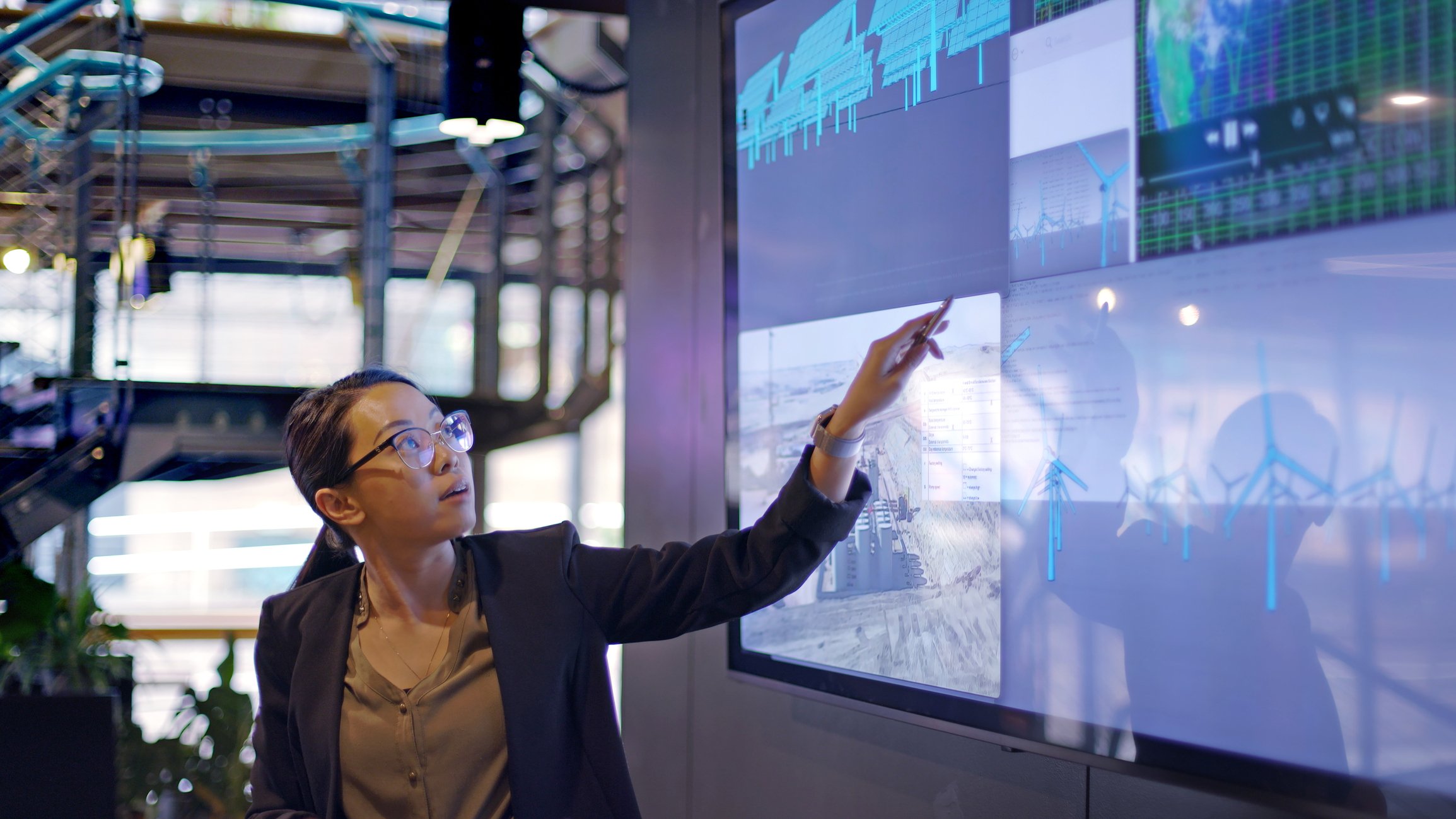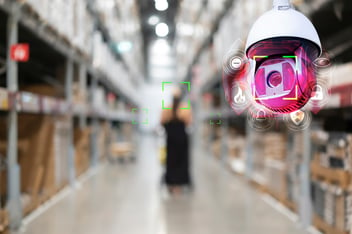EDITOR'S NOTE: The following article is a transcript of episode "Digitize Your Operations" from IFMA's Connected FM podcast. Thank you to our guests Matt Dawson, the Real Estate Engagement Leader at EY, Edward Wilson-Smythe, Director of Digital Innovation at Alix & Partners, Dr. Jake Smithwick, the Associate Professor at the University of North Carolina, Charlotte; and Jeffrey Saunders, the CEO at Nordic Foresight.
TABLE OF CONTENTS
What is digital transformation?
Common challenges taking reactive solutions to proactive solutions
Challenges with data analytics and data integration
Using data and research benchmarking in facilities
Setting a digital transformation vision for your organization
Keys to motivating change and cultivating successful digital transformation
How do you incentivize digital transformation?
What is digital transformation?
Jeffrey Saunders: Well, welcome all of you to this podcast and could you kick us off and define what digital transformation means for you in FM context?
Edward Wilson-Smythe: So from my perspective, digital transformation has three pillars. There are obviously the technology enablers of any new digital business model, digital interaction or digital ways of creating value, which is foundational to any discussion of digital transformation.
Beyond that, at Alex Partners, we've looked at it in two aspects. One is more traditional. What impact do those underlying technology enablers and accelerators have on the fundamental function of a space, whether it's in terms of efficiency, whether it's in terms of safety, whether it's in terms of environmental stewardship. The other aspect we looked at very intently, given the changes that are happening in society, driven by every decennial recession cycles, a significant shift in the work relationships and where people live and work after COVID 19, and generally the realization that the next generation may be the first generation in 100 years that will grow up poorer than the parents.
We're also looking at how society is being impacted by these trends, and as a result, what does that built environment and living space and workspace need to look like, and related to that, what can technology accelerators and enablers help shape that built environment for the future? Which we're convinced is not going to look like the built environments we inhabit today.
Jeffrey Saunders: Okay. So that's a broader transformation. That's really fascinating to get into and suss out some more. And that's that future direction. I was wondering, Matt, could you speak a little bit about how digital transformation is impacting your centralized and decentralized service offerings at EY and what does it mean for a facility professional?
Matt Dawson: Well, I think, and it was just a pickup on his comments, this year transformation for us is about taking the legacy systems into the future. Really most traditional FM operations are very reactive in their model and the future state to digitization. Centralization is about becoming more proactive in an always-on mode, a common platform, and you'd be able to deliver automated interconnected systems to reduce the human-in-the-loop time with unnecessary responses and to drive a greater sense of quality and a better user experience.
I think overall, you know, the drivers for us are keeping the user in mind first. Obviously cost, safety and security and sustainability. So the framework inside, much like the pillars that were referred to earlier. So I thought that was a wonderful capture point.
The way we look at it internally, with our digital workplace technology, is to focus on operational efficiency, health and safety, and obviously sustainability. Most importantly, a key pillar is around human experiences. So being able to advance those in a meaningful way through useful cases that have that impact is what's essential there.
Common challenges taking reactive solutions to proactive solutions
Jeffrey Saunders: That's fantastic. So, Jake, we heard Matt get into some conversations around bringing legacy systems and changing them from reactive to proactive.
And that requires a good deal of acquisition of new systems, setting new requirements on vendors. Could you give some insight on some of the research, on some of the common challenges or barriers that FM professionals are facing when trying to take these reactive solutions and make them proactive?
Dr. Jake Smithwick: I think one of the major things that we commonly see is that when we go through a technology transition, is, what do we do with all that data, right? I mean, as facility professionals, I'm sure as Matt can refer to that, we have a lot of data in a lot of places.
And so when we look to buy a new system, the age-old question is, well, what do we do with all that data? Do we transition it? Do we migrate it? Do we start from a clean slate? And so from that standpoint, that's a really important thing to think about. We have found in a lot of our research and other consulting efforts is that a lot of time that data is just, you know, garbage in, garbage out, right?
And if we're taking garbage data and moving it to a new system, that can certainly be an important part of it. Going back to Matt's comment about removing that, almost not the human element, but really taking, when people have to make decisions about something, that can create risk.
And the easier it is for people to understand what's actually going on, that can enable us to make things easier. I think the last thing I wanted to comment on is that, when you look at the technology space, in terms of like project management and acquisition and procurement, and compare that to construction, facilities management.
I mean, how long have we been building buildings, right? I mean, it's thousands of years, right? We've been doing that since the dawn of time. Technology, and managing technology, that's what, in the last... 20, 30 years, I mean, in earnest. And so for that reason, the skill sets and the capabilities of the people that are delivering these projects from a management standpoint, it's just frankly not as well developed from a technology and especially from a project management skill set.

Challenges with data analytics and data integration
Jeffrey Saunders: A lot of threads to pick up on. Edward, you work a lot with, of course, with the data component and the integration. What are some of the challenges you're seeing?
Edward Wilson-Smythe: Yeah, I think the biggest challenge we see is irrational exuberance around digital transformation and innovation. So, there's a lot of every one of our clients. And frankly, I spent about five calls a day telling my own colleagues that we need to be the adults of the room. Everything is not generative AI.
So, 90% of our clients do not have adequate data. Let's forget about good data and structured data and usable data. 90% of our clients do not have data that can be used for all these wonderful use cases that we talk about. So from our perspective, automation analytics AI starts at some fairly mundane, boring, doesn't get people too excited, doesn't hit the Medium or Fast Company headlines kind of stuff. In terms of, are you even generating data from your processes? If you're generating the data, are you capturing them in any meaningful way? Are the data being captured in a way that is understandable, consistent, and usable?
After, if those foundations are in place, then we can start talking about how you integrate them, how you create use cases around them. So we sort of take a three-step approach. Let's really define the data foundations, not in terms of... lakes, lake houses, meshes, whatever new terms are going to come up.
The foundations in terms of what data do you need to understand, manage, optimize your business processes. Do you have that data? If you do not have that data, what are your strategies to generate those data and capture the data? If you have that data, but they are not being captured, how do you capture and make sense of them?
So that's foundational. The next level above that is where we are actively challenging some of the orthodoxy around, well, step one, build a data lake. And we're saying, that's really good, but large-scale implementations of historically viewed data rarely support the kinds of real-time insights that are needed for operational improvement.
So we're really looking at, yes, there may be a place at a time for data lakes, but it's really about how do you capture the data at the point of impact? How do you enable human agents or automated agents to make decisions at the point of action? And how do you orchestrate the data?
A good example would be, this is probably the oldest use case in facilities management: preventative maintenance of large capital-intensive moving parts, elevators and escalators. Frankly, if I'm putting my elevator performance data in a data warehouse and analyzing that based on a power report every week, I am not going to be doing predictive maintenance.
I'm going to be doing analytics and historical analytics, but that data captured at that real-time monitor, being able to predict asset condition, being able to integrate with field services, being able to dispatch it and address issues is the second layer of the data that we talk about.
And the third layer above that, is really how do you capture all those insights and then beyond improved product performance or beyond asset performance, beyond cost efficiency, how do you then truly define what that, I think Matt mentioned that, what that experience was going to be for the product, right?
So we really look at data at those three levels, but without the foundation, 90% of our clients are not going to be at the next two levels, which sounds pretty fancy.
Jeffrey Saunders: Okay, fantastic. And Matt, what has been your experience with that journey that Ed has described so well?
Matt Dawson: It's interesting because we have a centralized real estate group that we've had in place for 10 years now. Globally centralized and a decentralized FM. So, you know, a recent project that I just stepped through that was a reminder to many of the points that we just raised.
We have an excellent structure of data. Not perfect obviously, it never is. Within data lakes and repositories and the like and had a fairly elaborate system of bots and other technologies. You know, beacon sensors, a whole lot of products to rationalize. And I think that you take that spectrum, it was fairly easy for us to work through a structured approach within the data domain relative to both structured and unstructured data using basically business process.
You know, what is the business process that you're aligned to so that you can identify what the most ideal source systems were? Because in some cases you have multiple systems and you have to pick a single source of truth that helps you rationalize, you know, based on business process, what tools are being used and perhaps select one or alternates or a way to, you know, certainly aggregate that data in an appropriate way.
When we looked in the FM organization, and this is going to sound a little shocking, there were several hundred applications. And that's because we're decentralized down to the country level. You have 151 countries and you have access of a lot of tools, Teams, SharePoint, you know, even some old legacy Lotus Notes apps to try to rationalize that and was the data even in a format where it could be consumed.
And it just became a monumental project. So when we looked at this and are trying to pull everything together, we're still working on this project and we've made a lot of headway. I would just, you know, sort of frame it this way. As we're stepping into digital transformation, we're bringing real estate and FM closer together in our environment, albeit organized and differently.
Geographically, the common platform really is essential. There's a level of complexity there, which we were just talking about and how you step through that: doing inventories of systems, then leading to data. What is source data? What is destinated data? How do you capture it? How do you give access? You know, the stewards, a lot of that sort of mind numbing activity that was just being discussed.
Then there's the cost implications around this of what you choose to do. And are we being intelligent in our application of technologies and the long-term sustainable cost? Then the really deep collaborations that are needed in order to forge to get the job done, particularly some new areas that I was just explaining around user experience, sustainability and the interoperability and how you really need to work across a lot of core business functions, IT, HR, CIO, CEOS in order to do that. With those expanded expectations, some of that we've been reviewing, it just means an increased chance of failure.
There are a lot of challenges out there. You know, the data challenges we're talking about, but if you look at it and you have a large legacy footprint, which I just described, there are some things that you have. You have a lack of standardization, all right? You have a lack of systems interoperability, cyber security, data, you know, data privacy sort of issues that you factor into as we were just mentioning. r do you have the right use cases and what you're trying to accomplish as an outcome.
And then how do you make this system work and in a centralized platform, believe it or not you know, getting to a simple solution is quite easy. The roadmap, the homework and the effort to get there is, can be a little daunting and you want to be smart about it and you don't want to eat the elephant in one sitting for sure [00:16:00] depending on the scope and scale of your operation.
Jeffrey Saunders: That was a fantastic overview of kind of the challenges of integrating all these different elements in a centralized function with a decentralized execution, trying to bring that into create some common set of standards that you can actually have something that, that is relevant and usable across the organization.
So I see that's a, quite a large and daunting challenge that I think is probably taking longer than you guys expected that it would take at the beginning of the journey.
Edward Wilson-Smythe: Indeed.

Using data and research benchmarking in facilities
Jeffrey Saunders: Jake, any reflections on the comments that Ed and Matt have had around the data component from the research that you've been doing?
Dr. Jake Smithwick: Yeah, absolutely. You know, one of the interesting things that we're involved with is a lot of benchmarking studies with IFMA. The North America O&M is kind of a flagship study. In recent years, we've done benchmark studies from an operations standpoint in Asia, Africa is just about done, first one of its kind, the Middle East, and it's interesting that a lot of times that we find it and kind of, Ed, you made allusions to like these data lakes, which kind of gives us this image in our mind of all this data everywhere and all sorts of different things.
What I found is that as an FM, you know, we do have access to a lot of data here. And what I find that going back to those benchmark studies, is that when we look at this data it's pretty insightful. The challenge though is that when you think about the benchmarking process, the main thing that it should be doing here is to motivate us to do something different, to motivate, to make a change based on what the data is telling us.
So many times, you know, my advice to a facilities practitioner is that once you have access to the data, make sure you take that final step, which is to do something with it. The last thing I'll say about that, it's kind of like a circle of life, right? If you're not doing any data collection at all, or benchmarking I would say, just start somewhere.
It really doesn't matter, right? As somebody who has maybe a small building or a larger portfolio, just do something to look at that data. Once you've got that data, then do something with it for maybe the next year. And then finally, the pinnacle, the best of this would be to do a year-by-year regular monitoring of that data, seeing what's going on, and taking those incremental changes to actually improve things. It's really quite fascinating as you think about it.
Setting a digital transformation vision for your organization
Jeffrey Saunders: The three of you and your comments are bringing up this question to me, you know, cause when you talk about digital transformation, ultimately it's about leadership because there's so many different directions and areas that you can take this journey in.
And then people talk about leadership in a digital transformation context. Oftentimes in FM space, there's a little bit of deers in the headlights about which direction should I take my organization in support of the core organization. Could each of you kind of speak to that aspect of ways to, you know, set a vision, the importance of setting a vision and what does that mean for the organization, FM context?
Matt Dawson: Perhaps the good starting place is just talking about our group's purpose within the enablement function that I lead specifically.
Our purpose is about providing actionable information for better-informed decisions.
Full stop. It's a business intelligence function.
And by framing it that way and how you can support the various aspects of the business, it's not necessarily the data that was generated, it's how it can be used, how it can be converted into information that is actionable. For instance, an example that gives currency and polishes your brand would be our office presence systems that we developed in terms of really doing space planning, you know, time, motion, those kinds of things, activity in the offices worldwide.
We completely reengineered that relative to COVID to show return to office and those metrics and track that and really be able to drive insights on a daily basis around the globe of activity, both from a health and safety perspective to begin with, and then around business resumption, RTO, and now back into space planning and rationalization of portfolios as we go forward.
So it's not what a system or data was designed to do, it's how it can be repurposed and combined with other elements in an intelligent format to really provide value back to your stakeholders. And you can start talking about examples in that way. Then you get the currency behind it. Then you get the support.
Then you find the foundations because you're producing something of value. And I think if you're looking at it from those lens and really transforming FM to really tell your story and creating more of a business intelligence function that feeds back in to the various groups which you have a reciprocal relationship and a growing partnership.
Whether it's with finance, procurement, IT and the like. I think that perhaps that's something to consider is certainly the approach that we've taken.
Jeffrey Saunders: Okay, so that fundamental question about how do we drive value for our organization and for our members. Ed, reflections on that.
Edward Wilson-Smythe: Yeah, so I'm going to say something that may sound a little controversial. Vision is overrated. Companies do not add value when creating visions. Companies add value by doing tangible things that make an impact on tangible business metrics. So our focus very much is that any activity has to be tied to driving a tangible action to result in moving the needle on a tangible business metric.
And very often, as long as we are prudent around the design and the architecture so that we're just not creating endless silos of point solutions which happens as well. It's very easy and pragmatic to get started to solve some simple fundamental problems and bootstrap our way over there.
I was talking with a client today and the discussion of, well, why should we wait until we have a vision? I said, well, you never have a vision done. Because you've been working on a vision for the last two years. So, why don't we just do something? And that bias for action, would be: take the most, either the most impactful or the most noisy or the most squeaky wheel and find a way to Matt's point, get the right data, get the right insights and try and solve that problem.
As opposed to you know, PowerPoint theater that we very often see when consultants get involved. So, I'd say vision is a lot less important than action. I'd say intelligence is a lot less important than action. Getting a dashboard to finance doesn't save a cent of money other than finance people to cut costs.
So I'd much rather have an initiative that allows a field service agent to be deployed proactively before an elevator breaks down, and I'd much rather have assist information that modulates building temperature, depending on occupancy levels as opposed to merely giving a report of what the building carbon consumption was to some ESG bureaucrat.
So, our focus would be very much on saying, let's identify specific and whatever those metrics are safety, cost of assets, asset uptime carbon footprint, energy usage. Whatever those metrics are, let's find practical solutions to move the needle toward a better point than we are today. And a lot of our work is focused pretty much with that philosophy.

Keys to motivating change and cultivating successful digital transformation
Jeffrey Saunders: Okay, fantastic. Jake, any reflections on that?
Dr. Jake Smithwick: One key thing here that we've seen, one of the questions that we research that we undertook a couple years back is: why do your change events, succeed versus not succeed? And again, going back to IT, any time you're buying or acquiring some sort of new technology, It's really a change event.
So we took on this research study to look at what is successful, what makes a change successful and versus you know, not as successful. So we collected a bunch of case studies projects that we had worked on, other friends of ours that have worked on, and we collected about 600 case studies, detailed case studies about what happened in those different booths.
And what's interesting about that, one of the number one things that we've found, It was directly correlated to a successful change of doing something different is a change agent. Now, when we think about a change agent, what that person is that inside of the organization, they're seen as a peer to the people are affected by that change.
And across every single thing that we looked at is having those key change agents on site that are rallying the troops, motivating the troops to actually adopt the solution by somebody seen as a peer to them. Not as somebody who's on high saying you shall do this, but rather as a peer is very successful to actually make those changes.
The other thing that on the other side of it is what doesn't make a change successful. Again, almost every single event we looked at is if you want your change event to fail, make sure you send an email about it and then have a marketing pitch about it, like a PowerPoint, right? Which is kind of funny because a lot of times that's how we do it, right?
And so I know this is kind of a different perspective here, but putting some of that, but a practical perspective from what we've seen is, we've got to focus on what makes a difference. The last thing I'll say about that as well is that, when you think about what motivates people to do something different at the end of the day, it's not the data.
It's not like, well look at this will save us a bunch of money, right? You have to tie it to, this might sound kind of weird, but we have to tie it to either the pain of what they're currently doing, personal pain. Or the pleasure aspect of it. And it really comes to get to psychology, right? The human aspects, the human dimensions of what are people thinking about and how it can go to either the pain side of it or the pleasure side of it to motivate people to do something different.
Because at the end of the day here, if we ask ourselves can we act, actually force people to change? And to do something different. I have a couple of kids and I will tell you, firsthand experience is really hard to get people to do something different.
Jeffrey Saunders: Matt, reflections on that as you're driving this kind of change in that you're managing different challenges, again, that centralization versus decentralization aspect where you have centralized corporate real estate function and the decentralized FM function. I'm sure you're dealing with change on a regular basis as you meet the standardization versus, "hey, we've always done things this way here."
How are you motivating change at EY?
Matt Dawson: A basic sort of simple part of change is if the new is not better, clearly better than the old –you know, it's sort of a Southeastern phrase – you're swimming upstream. Culture eats change every day of the week. And so, clearly whatever you're operating on, it has to be clearly better than the existing system.
And if there's not if it's not clear, there has to be a mandate to understand why you're driving that change forward that everyone can rally around. Much of what we do is self-determinative. When you're dealing in an enterprise situation and a part of change and to really build, you know, really build consensus.
You've got to have a fundamental trust. All right. And that trust leads to a point where you're going to minimize the conflict or the disruption that's around it. And then, by doing that, you really can clearly show that folks will remain autonomous. And to be able to do and be able to execute, which is really the point of what you're doing anyway.
So if you think about that autonomy and you think about how you achieve it, you've got to build trust. That trust is through providing an insight or solution that is clearly better than the old, making things easier, removing friction, streamlining, really making things better for the end result. And if that's not the case, you really should step back.
And understand because you're going to need that, otherwise you're going to find conflict, the effort could possibly fall in on itself. And that would be the framework that clearly, I'm sharing with you today that is a reflex and, you know, approaching change matters in pretty much everything that we do.
Jeffrey Saunders: And any reflections on what Jake and Matt had to say?
Edward Wilson-Smythe: Yeah, I'd say, you know, nothing focuses the mind like a crisis. And if anybody in this podcast does not believe that the commercial real estate business, at least, and facilities management related to that, isn’t in a crisis you know, that would be surprising.
So we typically get involved, not when companies are fat and happy, but when companies are distressed or companies are facing existential questions. So, nothing, you know, as I said the typical barriers you look at middle management, career protectionism or the whole focus on you know, the getting into execution details to say why a good idea cannot be executed or I think Jake made a point, you know, we've always [00:29:00] done it this way here.
Typically, we see that their external forces in the middle of a crisis, whether it's a new owner. Whether it's management changes, whether it's activists, investors writing nasty memos for you to get your ship in order, it's absolutely critical to understand that this industry right now does not have the luxury of taking the traditional, let's wait it out, let's have a bunch of bureaucrats in a room, sit together and figure out a pretty PowerPoint that decides a road map approach and as long as those conditions are there change becomes surprisingly easy because a lot of the barriers are self, a lot of the barriers are self created through a bunch of reasons.
So I think our focus is really working with the stakeholders who understand the need for imminent change and not with stakeholders who tell us why certain [00:30:00] things cannot be done because if you're in a city with 25 to 30% occupancy in commercial real estate, very soon that person is going to be out of a job.
And very soon the person who is willing to take a risk to make a small change that has a tangible impact on the business metric that somebody can take to the bottom line and reflect in free cash flow or improve share valuation is going to prevail. So our approach is very much looking at companies that have imminent need for change where a lot of the traditional barriers are just unsustainable just based on the pressures and headwinds that they're facing.

How do you incentivize digital transformation?
Jeffrey Saunders: And yeah, this leads me to that conversation. We dance in a little bit around it. When we have this conversation on digital transformation, but how do you incentivize it? And, you know, when we start talking about in a deflationary environment, particularly if you start talking about office environments [00:31:00] and central business districts that are facing, you know, 30, 40, 50% vacancy rates or in different types of commercial real estate focused towards the retail environment.
So that some of these aspects where we're going to have to start thinking Some new and different ways and that kind of creates a different challenge. Matt, do you have any comments around that? You mentioned the RTO and the rationalization discussion and showing value related to that. How are you thinking about some of these conversations around the rethinking and resizing of footprints that organizations are doing and how they're thinking about their digital transformation portfolios?
Matt Dawson: Well, I think that you find there are compelling reasons and there are industries that will be in distress. There'll be industry segments within the industries that will be in distress. And I think that's true, you know, throughout time, throughout business cycles. So I don't disagree that crisis or a focus will effectively drive change.
And then financial resources can be somewhat constrained and limited. I think that the principles, what you're talking about in terms of digitalization and the framework that you're operating in, there's always, a business case, a proper business case where you make investments that get a strategic return.
Whether it's a business driver, whether it's an acquisition or your industry is under distress, there are always financial pressures that have to come in and you have to be intelligent about the application of technology. You don't want to go out and create something that you can't afford to maintain or sustain.
You want to look at that in a very holistic way. In some cases, taking incremental steps can do this. I think a good example, and I'll just step through this fairly quickly at a high level if it's helpful, is when you look at AI, a really new technology that is extremely disruptive. It's got a very low threshold for user acceptance.
In fact, it's been adopted so quickly, the curve is so exponential. We've never seen anything like it before. So how do you apply that in the marketplace? And I know that's a very very dynamic and a very important topic that is included in digitization. But I think that, if I would just frame, I want our people to be involved.
We can't use it at work. For security and safety, EY is in the forefront of that, right? It's one of those technologies that you really want to be able to instruct it on what not to do. Because it's able to do so much. And there needs to be good governance and what not. But at the same time, it costs little to no money to encourage people to go out and get their knowledge on.
So that they're not fearful of that disruptive technology. That they do begin to understand what prompt engineering is about. That they do understand how it can be applied. Indeed. Our current chair had a very nice article he just produced where you can take those incremental quick wins and look at ways that it can apply and be meaningful and provide a result rather than the more enterprise-level type actions that you would embed in a fabric or predictive analytics has been there for a while that tells you what's going on causal, which is coming along with brand new math and algorithms that will tell you why.
And then, of course, you have generative that will tell you the what and the where, but that's coming. So to be able to inform and to be able to explore how you can make those quick wins and AI to the extent that you can leverage, help our people become more familiar about disruptive forces so they can educate and embrace and understand how to use this new tool in an appropriate way, because it will impact our ability to do tasks half or better.
But you need to be out in front of it so you can jump up the S curve and differentiate yourself and how you can apply and leverage that tool in a different way. And I think that's a focus. The flip side on the economics of what not is a different discussion for a different day, but I do think that you can take a topic like AI and explore it within finite resources, whether it's in a small application or if you're looking from a strategic standpoint. How you can apply it as a disruptor in your business to create more efficiency inside of your operation? And operational efficiency has been a cornerstone of IFMA since the start of the profession. That's, you know, the bread and butter of what we do.
Jeffrey Saunders: Fantastic. Jake, any final comments on that?
Dr. Jake Smithwick: When we think about technology and every single time that we've seen a new technology you look at things differently, right? The example here at the university, I mean, Chat GPT, for example, has had major disruptions in how, as educators, we engage with our students, right? But, broadly speaking, as an industry of facilities professionals, and looking at this new technology here, the main thing that I think about is being early to adopt something that's good, depending on what that is here. But, again, how many times have you seen other technologies come in?
And we start getting on the bandwagon and only realize, well, this doesn't make things easier, right? When you go back, you know, decades ago, that technology was meant to save everything from like a construction drawing standpoint, right? And the technology and its ability to do some of the things that it's meant to do just really hasn't come about yet.
Jeffrey Saunders: Ed, last reflections before we sign off for today?
Edward Wilson-Smythe: I mean, very quickly, I think digital transformation can also help recessionary industry that's facing significant headwinds. If we focus the efforts single-mindedly on cost reduction, which I know is not as exciting for all the digital transformation people out there.
It's always about creating the next Uber or creating the next whatever, but the reality is that the significant cost that can be taken out of the built infrastructure that we have today across all levels, whether it's maintenance, whether it is environment, whether it's energy, whether it is safety, security, people, costs and we've shown our eyes on all of those related to just driving costs out.
I think a lot of focus on innovation in this industry has necessarily got to focus on the boring stuff. Because distressed industries, yes, need innovation to redefine themselves, but they cannot redefine themselves if they do not have free cash flow to invest in that redefinition. So I'd say take that pragmatic approach to look at where can you drive the ruthless cost savings through automation, through predictive maintenance through predictive energy consumption, and then look at how can you then rethink the purpose of a building.
A good example is New York City. Two of the headlines in New York City, anybody picks up any newspaper of any political bent is that there is record high levels of office vacancy and Hudson Yards looks like a ghost town. There's record high numbers of people in perilous housing situations that's non-housed people and undocumented workers who are having trouble with housing we haven't seen too many leaders beyond speaking to the press and scoring points, address an obvious demand-supply situation that technology innovation can help.
However we're not focused on the immediate things that will help a distress industry. And we're not focused on the long-term redefinition of what that industry looks like. And that leaves us in this mushy middle of data, analytics, dashboards, plans, etc., that don't address the two foundational crises facing this industry.
One, the current cost structure and the current built infrastructure is unsustainable for the social and economic patterns of today and in the near future. That's not changing. People are not coming back to work at the same levels as before, whether companies threaten it or whatever they do. The second is that there is an immediate need to reimagine what these built spaces can withdraw.
These built spaces can play in a society that's evolving in the future. And I think we need to address those two things. In addition to this mushy middle of data, information, dashboards, et cetera, et cetera, to be truly to have a true impact of digital innovation in this industry.
Jeffrey Saunders: Fantastic.
Unfortunately, we've reached the end of our session today and it's been wonderful to have Ed, Jake, and Matt join us. Thank you all for taking the time out of your very busy schedules to share your insights and information on this topic. And if you're interested in having greater insights and really focus on the topic, please join us on October 10th in Boston, where we're doing a Deep dive on how to digitize your FM operations, where you can hear directly from Ed, Jake, and Matt, and from a great deal more subject matter experts on this field as we really dig in deep about how we could digitize the operations and focus on what really drives value for your organizations.














